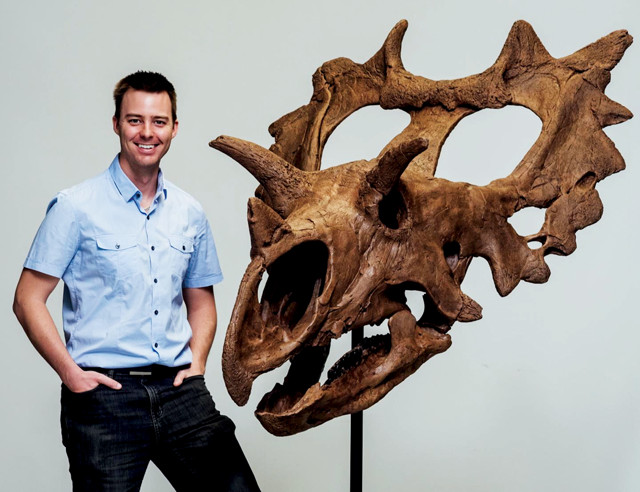
by Mary Caperton Morton Tuesday, September 13, 2016

Jordan Mallon stands with the reconstructed skull of Spiclypeus shipporum, a newly described genus and species of horned dinosaur. Credit: ©Canadian Museum of Nature/Martin Lipman.
The Triceratops family tree just got a little spikier. A decade ago, a retired nuclear physicist uncovered the large skull, legs, hips and backbone of a dinosaur on his land near Winifred, Mont. Now, the remains have been identified in a new study as a new member of the ceratopsid family, dubbed Spiclypeus shipporum, meaning “spiked shield.”
Ceratopsids are known for their elaborate head gear, and Spiclypeus doesn’t disappoint. Unlike the well-known Triceratops, whose facial spikes jut forward, the horns of Spiclypeus stick out laterally from its skull. The new species also has a unique arrangement of bony spikes making up the neck frill, with some spikes curling forward while others project outward.
“In this sense, Spiclypeus is transitional between more primitive [ceratopsid] forms in which all the spikes at the back of the frill radiate outward, and those such as Kosmoceratops in which they all curl forward,” said lead researcher Jordan Mallon, of the Canadian Museum of Nature in Ottawa, in a statement.
The Montana dinosaur, which lived about 76 million years ago, may have lived part of its life in pain, as its upper arm bone shows evidence of arthritis and a long-term bone infection, Mallon’s team reported in PLOS ONE. Nicknamed “Judith” because it was found in the Judith River Formation, a preserved silt deposit left along a flood plain that has proved rich in dinosaur fossils, the specimen is on display at the Canadian Museum of Nature until Nov. 13.
© 2008-2021. All rights reserved. Any copying, redistribution or retransmission of any of the contents of this service without the expressed written permission of the American Geosciences Institute is expressly prohibited. Click here for all copyright requests.